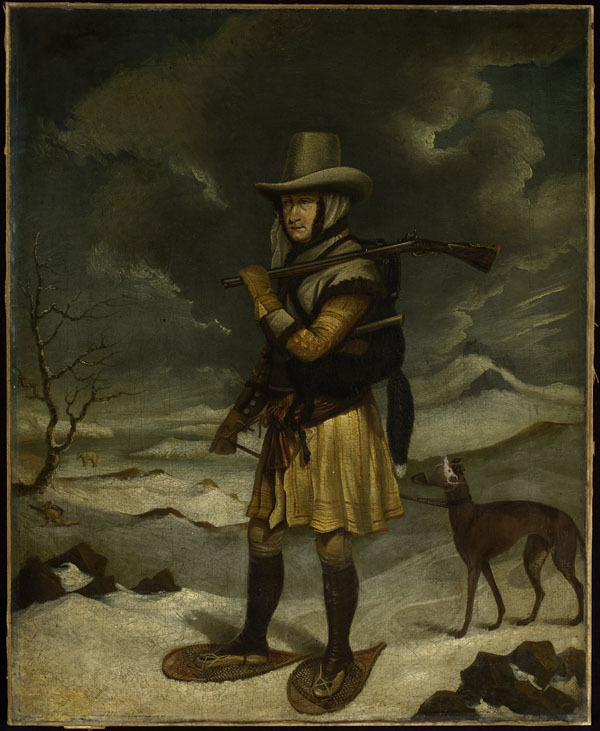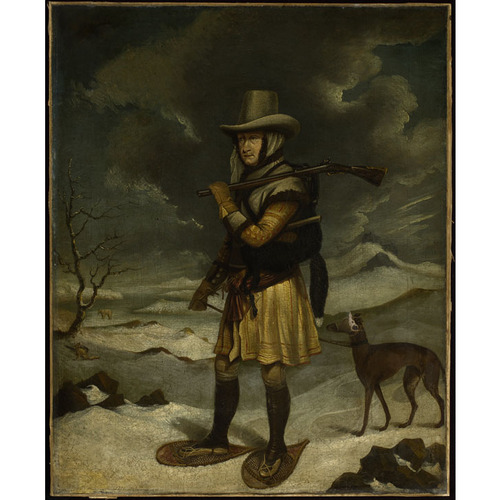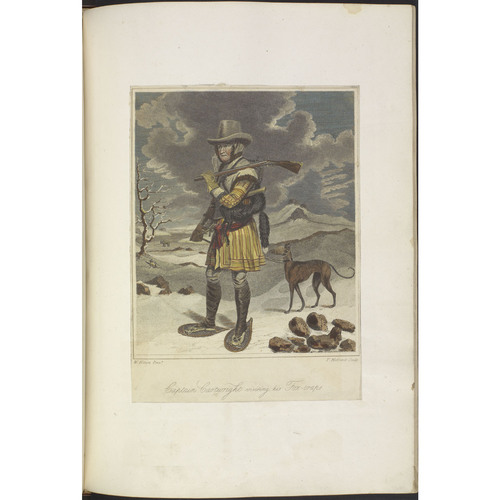CARTWRIGHT, GEORGE, entrepreneur, sportsman, and diarist; b. 12 Feb. 1739/40 in Marnham, England, second of ten children of William Cartwright and Anne Cartwright; d. unmarried 19 May 1819 in nearby Mansfield.
George Cartwright was born into an old landed family which had risen to prominence in the 16th century and was now in straitened circumstances. The father was a man of modest but distinct originality within his circle in Nottinghamshire; the mother was a daughter of George Cartwright of Ossington; and three of their sons achieved celebrity in different fields. John first pursued a naval career and through it was closely connected with George’s early ventures in Newfoundland, and later, after his resignation in protest against participation in the American Revolutionary War, became a radical pamphleteer. Edmund, the youngest, was a scholar, poet, experimental agriculturist, and inventor of the power loom. Finally there was George himself.
Educated at Newark and at Randall’s Academy, in Heath (West Yorkshire), George was entered at the age of 15 or 16 as a gentleman cadet in the Royal Military Academy at Woolwich (London), where he was instructed for a year; and on 6 March 1754 he sailed to India with a dozen other cadets to take up commissions in the army as they might become available. In 1755 he became an ensign in the 39th Foot, but to his regret missed being with the detachment commanded by Robert Clive at the retaking of Fort William (Calcutta), the capture of Chandernagore from the French, and the victory at Plassey over the nawab of Bengal. Recalled home, the regiment was stationed in Ireland at Limerick, and Cartwright was promoted lieutenant on 2 Feb. 1759. Early in 1760 he accompanied the Marquess of Granby to Germany as aide-de-camp and served as a staff officer with the British contingent under Duke Ferdinand of Brunswick. He returned to England at the end of the Seven Years’ War as a captain in the army (from 21 May 1762). Burdened by debt, he went on half pay.
In the spring of 1765 he was residing in Scotland both to live economically with a mistress and entourage and “to indulge my insatiable propensity for shooting.” The following winter he spent in London and in cruising with his brother John to control the smuggling trade in home waters. In the spring of 1766, on John’s appointment as first lieutenant of the Guernsey, flagship of Commodore Hugh Palliser*, George sailed with the governor-designate to Newfoundland where he spent a season cruising along the northeast coast. Returning to England, he obtained a captaincy in the 37th Foot through the influence of Granby, now commander-in-chief, joined the regiment in Minorca, but was invalided home with malaria in 1767. A second voyage to Newfoundland with John followed in the spring of 1768, in the course of which he played a part in the expedition dispatched by Palliser under John’s command into the interior of the island to establish friendly relations with the Beothuks at Red Indian Lake. An interest in the region and its native peoples coupled with disappointing prospects for advancement in the army determined Cartwright on his next career as a trader and entrepreneur in Labrador, and in 1770 he went on half pay.
Competition between English and French fishermen, the often fierce rivalry between different English merchant houses, the endemic hostility between natives and Europeans, raids by American privateers, and the problems created by the divided jurisdiction of Quebec and Newfoundland authorities provided an unstable and troubled setting for Cartwright’s activities during 16 years on the coast. The scene of his operations from 1770 to 1786 was the stretch of coastline between Cape Charles, where he occupied Nicholas Darby*’s old site, and Hamilton Inlet. From the stations he established he engaged with his servants and sharemen in the fisheries for cod, salmon, and seals, and the trade in furs. His ventures were undertaken in a number of financial arrangements and partnerships: between 1770 and 1772 with Francis Lucas*, Jeremiah Coghlan*, and Thomas Perkins, the latter two of Bristol; on his own account with money advanced by his father in 1773; with Robert and John Scott from 1773 to 1776; with Benjamin Lester of Poole between 1783 and 1786; and others. There were years of success, but others of failure, and in 1778 his posts were plundered by American privateers with losses amounting to £14,000. The final result, not to be attributed to Cartwright himself, was bankruptcy, the causes of which are recorded in detail in the journal which he kept for most of these years and which he published in 1792 after his return to England.
The journal contains much else. It is, among other things, a detailed seasonal record of the exploitation of coastal resources by one who combined keen entrepreneurial interests with an inextinguishable zest for the chase which made him nature’s nemesis; a finely observed record of natural history and meteorology; and, above all, testimony to a persistent, curious, and resourceful mind. In his relations with the native peoples of Labrador, especially the Inuit, Cartwright displayed an honesty which led to mutual trust. In 1772 he took a family of five Inuit to England, where they created considerable interest, meeting with the king, members of the Royal Society including Joseph Banks, and James Boswell, who reported to a sceptical Samuel Johnson his ability to communicate with them by sign language. The poet Robert Southey, who had met Cartwright in 1791, recorded in his Common-place book: “I read his book in 1793. . . . This man had strength and perseverance charactered in every muscle. . . . The annals of his campaigns among the foxes and beavers interested me far more than ever did the exploits of Marlbro’ or Frederic; besides, I saw plain truth and the heart in Cartwright’s book – and in what history could I look for this? Coleridge took up a volume one day and was delighted with its strange simplicity.” What has only recently been properly recognized, however, is the interest of Cartwright not only in the Inuit language and its study, but also in making himself a glossarist of 18th-century Newfoundland English; and he was a close student of and perhaps contributor to the work of such scientific contemporaries as Banks, Thomas Pennant, and Daniel Carl Solander. Of his sole essay as a poet, “Labrador: a poetical epistle” (composed in 1784), Cartwright himself warned the reader: “Tho’ I have often slept whole nights on mountains as high as that of famed Parnassus, yet, never having taken a nap on its sacred summit, it cannot be expected, that I should have awoke a Poet.” Yet less interesting verses have attracted the industrious attention of Canadian literary historians, and among writings from the New World a more singular 18th-century document than the journal itself is hard to find.
After 1787 Cartwright resided in England, where he had inherited with his brother John a share of their father’s estate. He was occupied from time to time in the legal consequences of his Labrador ventures and partnerships and with attempts to establish rights to certain Labrador coastal properties; and in 1793 he gave evidence before a committee of the House of Commons on affairs in Newfoundland and Labrador. His military experience led to his appointment during the Napoleonic Wars as barrack master at Nottingham where in later years, known by the sobriquet “Old Labrador,” he was a distinguished and popular figure. A handsome man of strong and robust figure and unbending tory principles, he was courtly and agreeable in conversation. He died in 1819 at the age of 80, characteristically occupied on his deathbed with proposals to the Hudson’s Bay Company to establish trading-posts on the coast of Labrador, where his name is borne by a settlement at the entrance to Sandwich Bay.
[There are documents relating to Cartwright’s applications for land grants and fishing rights in Labrador, 1785–88, in the PAC, RG 1, L3L: 28. Miscellaneous family papers are in the possession of Patricia and John Cartwright, Johannesburg, South Africa; see Ingeborg Marshall, “Inventory of the Cartwright papers” (typescript, 1979; copy at the Memorial Univ. of Nfld. Library, Centre for Nfld. Studies, St John’s). g.m.s.]
Maritime Hist. Group Arch., Cartwright name file. [George Cartwright], Captain Cartwright and his Labrador journal, ed. C. W. Townsend (Boston, 1911); Journal of transactions and events, during a residence of nearly sixteen years on the coast of Labrador . . . (3v., Newark, Eng., 1792). DCB, vol.4 (biogs. of Jeremiah Coghlan and Sir Hugh Palliser). DNB (biogs. of Edmund Cartwright and John Cartwright). C. R. Fay, Life and labour in Newfoundland (Toronto, 1956), 78–82. W. G. Gosling, Labrador: its discovery, exploration, and development (London, 1910), 222–50. J. P. Howley, The Beothucks or Red Indians: the aboriginal inhabitants of Newfoundland (Cambridge, Eng., 1915; repr. Toronto, 1974, and New York, 1979), 49–54. H. A. Innis, The cod fisheries; the history of an international economy (rev. ed., Toronto, 1954). A. M. Lysaght, Joseph Banks in Newfoundland and Labrador, 1766: his diary, manuscripts and collections (London and Berkeley, Calif., 1971). The life and correspondence of Major Cartwright, ed. F. D. Cartwright (2v., London, 1826; repr. New York, [1972]). P. [A.] O’Flaherty, The rock observed: studies in the literature of Newfoundland (Toronto, 1979), 34–42. Prowse, Hist. of Nfld. (1895), 598–601. C. W. Townsend, Along the Labrador coast (London, 1908), 207–28. G. M. Story, “`Old Labrador’: George Cartwright, 1738–1819,” Newfoundland Quarterly (St John’s), 77 (1981–82), no.1: 23–31, 35. W. H. Whiteley, “Newfoundland, Quebec, and the administration of the coast of Labrador, 1774–83,” Acadiensis (Fredericton), 6 (1976–77), no.2: 92–112; “Newfoundland, Quebec, and the Labrador merchants, 1783–1809,” Newfoundland Quarterly, 73 (1977), no.4: 17–26.
Cite This Article
G. M. Story, “CARTWRIGHT, GEORGE,” in Dictionary of Canadian Biography, vol. 5, University of Toronto/Université Laval, 2003–, accessed January 4, 2026, https://www.biographi.ca/en/bio/cartwright_george_5E.html.
The citation above shows the format for footnotes and endnotes according to the Chicago manual of style (16th edition). Information to be used in other citation formats:
| Permalink: | https://www.biographi.ca/en/bio/cartwright_george_5E.html |
| Author of Article: | G. M. Story |
| Title of Article: | CARTWRIGHT, GEORGE |
| Publication Name: | Dictionary of Canadian Biography, vol. 5 |
| Publisher: | University of Toronto/Université Laval |
| Year of publication: | 1983 |
| Year of revision: | 1983 |
| Access Date: | January 4, 2026 |





